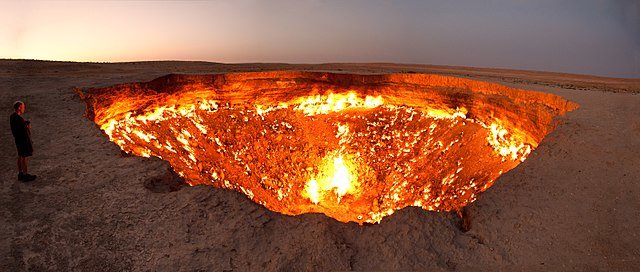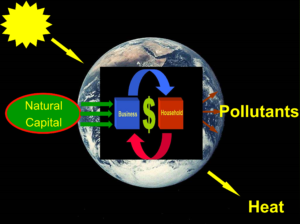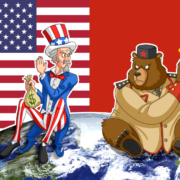A Journey of No Return, Not a Circular Economy
by Herman Daly
The economic process is not a mechanical analog that can be run forward and backward, nor a circular process that can return to any previous state. Rather it is an irreversible and irrevocable process moving in the direction of time’s arrow of increasing entropy.[1] Finitude and entropy guarantee that the economic life of our species will be a journey of no return. Therefore even a stationary economy, in the classical sense of constant population and constant capital stock, is ultimately a journey of no return, because the metabolic throughput of matter and energy required to maintain constant stocks of people and physical capital, in the face of depreciation and death, is an entropic flow from ever less concentrated sources to ever filling sinks—and both sources and sinks are finite.
Consequently, technology must change qualitatively to adapt to entropy increase, to depletion and pollution of the environment, even in the stationary, or “steady state economy” as it has been more recently called. Relative to the growth economy, the steady state economy is a slower journey of no return, one that values longevity with sufficiency, and seeks qualitative improvement rather than quantitative increase. The many advantages of a slower journey were emphasized by John Stuart Mill [2], the champion of the classical stationary state:
“I know not why it should be a matter of congratulation that persons who are already richer than anyone needs to be, should have doubled their means of consuming things which give little or no pleasure except as representative of wealth….”
“The density of population necessary to enable mankind to obtain in the greatest degree, all the advantages both of cooperation and of social intercourse, has, in all the most populous countries been attained….”
“It is scarcely necessary to remark that a stationary condition of capital and population implies no stationary state of human improvement. There would be as much scope as ever for all kinds of mental culture, and moral and social progress; as much room for improving the Art of Living and much more likelihood of its being improved, when minds cease to be engrossed by the art of getting on.”

The Darvaza gas crater in Turkmenistan was created when Soviet engineers were drilling for oil and hit a natural gas pocket that swallowed their equipment and has been burning ever since. (CC BY-SA 2.0, Tormod Sandtorv)
In contrast to Mill’s vision of the steady state, the reality of today’s growthist economy is one of harried drivenness, of frantic adaptation to the unforeseen, unwilled, and out of control consequences of maximized, subsidized growth, pushed by ever larger scale and more dangerous technologies. Such growth is now threatening the capacity of earth to support life, and certainly healthy lives.
Many are not content with a slower, more careful journey of no return. They want a so-called “circular economy” that can presumably live, and continue to grow, by ingesting only its own waste products. They assume that what they consider desirable must therefore be possible.
For anyone who has taken the first course in economics, the recently revived term “circular economy” calls to mind the famous diagram of the circular flow of exchange value between firms and households found in the first pages of the standard textbooks. That diagram shows goods and factors of production flowing in a closed circle between firms and households, with money flowing in the opposite direction.
In the diagram, the economy is represented as an isolated system—nothing enters from the outside, nothing exits to the outside. There are no natural resources entering from the ecosphere, no wastes exiting back to the ecosphere. Indeed there is no ecosphere, no containing and constraining environment of any kind. This abstract vision is useful for studying exchange (supply, demand, prices, and national income), but worthless for studying environmental costs of economic growth because there is no finite environment to constrain growth.
This picture however is not what most advocates today mean by “circular economy”, but it has a similar name of long standing, and is a source of confusion. By “circular economy” they mean an economy that recycles material natural resources to a high degree, increases product lifetimes, and uses mainly renewable resources—all good policies, but destined to fall short of their goal of “sustainable growth”. It might better have been called a “recycling economy” or an economy that maximizes natural resource productivity rather than labor or capital productivity.
Increased resource efficiency is also referred to as “decoupling” as in disconnecting the output of goods and services from the throughput of resources. A totally “decoupled economy” would take us back to the neoclassical circular flow representation of the economy as an isolated system. For this reason, I prefer to avoid this reborn notion of “circular economy” and the related term “decoupling”, because they greatly overstate the degree of separability of production from resource throughput, further encouraging the unrealistic quest for “sustainable growth” in physical scale of the economic subsystem relative to the biosphere.

The circular flow is embedded on planet earth. For the circular flow of the economy to grow, it takes up more and more of the natural capital of the earth and produces more and more waste heat and pollutants.
The heavy emphasis on circularity casts a deep shadow over the more basic fact that the metabolic throughput is fundamentally a linear, one-way entropic flow. Yes, the overall linear flow can contain important countercurrents and reverse eddies of recycling, and it is important to take advantage of that. But the river itself flows from the mountains to the sea, and never backwards. True, the hydrologic cycle powered by the sun can evaporate the water to rain again in the mountains, but that happens in the ecosphere, outside the economy.
If the “circular economy” relies on natural biophysical cycles powered by the sun, and does not grow in scale beyond the regenerative and absorptive capacities of the containing biosphere, then it approximates a steady state economy—not a sustainable growth economy. In addition to a circulatory subsystem (recognized since the Physiocrats’ analogy with blood circulation), the economy also has a digestive tract that ties it to its environment at both ends. That second, more basic metabolic analogy has been neglected in economic theory.
Similarly neglected is what Brian Czech called the “trophic structure” of the economy in his book Supply Shock [3]. In the study of ecology, “trophic” refers to the energy flows associated with ingestion, digestion, and the growth of organisms. Primary producers (plants) are distinguished from primary consumers (herbivores) and secondary consumers (omnivores and predators). These are the three basic trophic levels comprising an ecosystem. Without the primary producers, there is no economy of nature, and the same principle applies to the human economy. Without agricultural surplus, no manufacturing or service sectors arise, and a growing economy requires more agricultural and extractive surplus at the base. This trophic reality supplements the fundamentals of throughput and helps demonstrate the folly of “decoupling.”
Meanwhile, recycling is limited, first because it costs energy to carry out the recycle of materials; and second because energy itself is not subject to recycling (entropy means that it always takes more energy to effect the recycle than the amount of energy recycled—regardless of the price of energy). The extra energy for the recycling also requires material instruments, trucks, etc. So materials can be reduced, but at the cost of an increase in energy (and material) throughput, which after some number of cycles (how many?) becomes prohibitive, as remaining materials are ever more dispersed. Even expensive metals like gold, silver, and copper are currently only about one-third recycled and two-thirds newly depleted. Writers who expound the circular economy seem to be aware of this fact, but do not give it sufficient emphasis.
It is also important to distinguish prompt materials recycling that is internal to the economic subsystem from long-run, external recycling through the containing ecosphere. While increased reliance on renewable resources is a good feature of the “circular economy”, one must remember that, when exploited beyond sustainable yield, renewable resources effectively become nonrenewable. There is always a scale limit to a sustainable economic subsystem, beyond which growth, even in a “circular” economy, breaks down, and sustainability requires a steady state economy.
The basic issue of limits to growth that the Club of Rome did so much to emphasize in the early 1970s needs to remain front and center, with recycling considered as a useful accommodation to that limit, but not a path by which the growth economy can continue. Well before becoming physically impossible, the growth of the economic subsystem becomes uneconomic in the sense that it costs more in terms of sacrificed ecosystem services than it is worth in terms of extra production.
That richer is better than poorer is a truism. No dispute there. But is growth in GDP in wealthy countries really making us richer by any inclusive measure of wealth? That is the question. I think it is likely making us poorer by increasing unmeasured “illth” faster than measured wealth. Even a steady state economy can be too big relative to the ecosphere. The neoclassical circular flow picture can never be too big by virtue of its being an isolated system.
Inevitably, national growth economies reach a point where many citizens begin to suspect that growth is no longer worth the cost of excessively rapid adaptation to an accelerating economy of no return—that so-called economic growth has in reality become uneconomic growth. John Stuart Mill recognized that long ago. Why have not more recognized it? Why is growth still the summum bonum of economists and politicians? Probably because growth is our substitute for sharing as a cure for poverty. And because our national accounts (GDP) are incapable of even registering uneconomic growth because they count only value added by labor and capital, and omit entirely the cost of using up that to which value is added, namely the entropic flow of natural resources, the very sap of life and wealth.
Footnotes
[1] Nicholas Georgescu-Roegen (1972). The Entropy Law and the Economic Process, Harvard University Press.
[2] John Stuart Mill (1857). Principles of Political Economy, vol. 2 (London: John W. Parker), pp. 320-326, with omissions.
[3] Brian Czech (2013). Supply Shock: Economic Growth at the Crossroads and the Steady State Solution. New Society Publishers.
 Herman Daly is an emeritus professor at the University of Maryland School of Public Affairs and a member of the CASSE executive board.
Herman Daly is an emeritus professor at the University of Maryland School of Public Affairs and a member of the CASSE executive board.







Whilst I agree with the critique above, I think it would be a mistake to dismiss the narrative of a Circular Economy. We do need a balanced system that does not depend on economic growth. This zero-growth economy can unfortunately give the implication of a flat-lining society where nothing is happening. Steady and stable with no opportunity for growth and aspiration. Whilst the vision of a steady state economy is precisely what we should strive for, the narrative is counter-productive. The literature does include suggestions that a steady state economic system would be dynamic, just like ecological systems, yet the term itself—steady state—is unappealing.
I have a copy of Herman Daly’s ‘Toward a Steady State Economy’ (1973) (with price tag $3.95) that illustrates the idea on the cover with circles within circles.
The Circular Economy has captured the popular imagination. It expresses the dynamic character of the economy proposed by steady state economists, while the principles of the Circular Economy—systems thinking, life-cycle planning and striving for zero waste—are entirely consistent with a steady state economy. The circular terminology is useful because there is growing momentum amongst business groups and various mainstream institutions around a suggested transition ‘From a Linear to a Circular Economy’, also providing a clear and concise narrative for the transition.
Humans are an organic part of finite planetary ecosystems. They expand exponentially in numbers using their invented technosphere to accelerate this expansion (approximately 150 extra humans added to the finite planet every minute of every day). Eventually this infinite trajectory of growth is bound to collapse, either due to depletion of resources or toxicity of the environmental sinks into which waste is deposited. In this expansion-followed-by-collapse process, humans resemble all other higher level trophic species. Like rabbits that overgraze the finite supply of grass, the dynamic of environmental regulation will eventually lead to collapse of human populations, if technological means such as nuclear war do not do so at an earlier stage. The complexity of the Machine World created by humans upon the Natural World makes it hard for most policy-makers to see the big picture. Daly’s (and Mills’) critique of the failure of conventional economic thinking, driven by innate human acquisitiveness and the dangerously flawed metric of GDP is, sadly, a warning too easily lost in the dangerous imagined decoupling of the Machine World (Technosphere) from the Natural World (Geosphere). That entropy eventually trumps circularity is also a powerful and timely reminder of the physics that underlies life processes. Thanks for elaborating another fundamental aspect of the ‘big picture’.
It depends where we draw the boudaries, as always. My own reflections only look at a Circular Industrial Economy of manufactured objects and materials, a shift towards this will open:
• a potential to create local jobs of all skill levels, and to drastically reduce CO2 emissions (by 66% on a national level), resource consumption and waste,
• opportunities for innovations, for instance in processes and technologies to develop a new circular chemistry enabling to preserve the value of material stocks by recovering atoms and molecules, to replace the waste management strategy of recycling, and in motivating the owner-users of objects to focus on enjoying the use of, and caring for, their assets,
• new approaches in policymaking based on human labour as a renewable resource, and a new definition of waste as objects without positive value and without liable owner. An Extended Producer Liability for objects then motivates waste prevention at the source.
In a new book, I have detailed these ideas: The Circular Economy – a user’s guide by Walter R. Stahel, with a foreword by Dame Ellen MacArthur, Routledge, London, May 2019.
https://www.routledge.com/The-Circular-Economy-A-Users-Guide-1st-Edition/Stahel/p/book/9780367200176
I completely agree, this is why I preface all my workshops and presentations on CE with this quote “…useful, low-entropy energy and materials are dissipated in transformations that occur in economic processes, and they return to the environment as high-entropy wastes. The economy, then, functions as a conduit for converting natural resources into goods, services, human satisfaction, and waste products. Increasing entropy in the economy sets the limit on the scale it can achieve and maintain.”
Nicholas Georgescu-Roegen “The Entropy Law and the Economic Process”, 1971
I also agree that we must stop promoting growth, as it should be clear that infinite growth of anything on a finite planet is impossible.It is not clear only to the majority of economists and others, who just cannot understand the immutable laws of nature, the laws of thermodynamics being the most critical to understand. As an engineer, my whole system of reference is based on the laws of physics, which helps as I work with others to conceptualize and practice, in the best possible ways, a new model of living and working that will give us another ~5 billion years on Earth, when the planet will hit the natural point of no return.
The problem is that we need urgently an alternative economic model. I chose Open Source Circular Economy, but there are many others that give us a chance to, first, abandon the current one for good, second, save the biosphere and bring human civilization in balance with the planetary natural cycles. I describe CE as a model of maintenance and avoid mentioning growth (unless it’s necessary to eliminate poverty, hunger, lack of meaningful and dignified work), zero waste, closed loops etc.
As with every new idea or model there is a mainstream approach, what might be called the corporate CE, as promoted by the Ellen MacArthur Foundation with the claim that all we need to substitute is the type of growth, to make it “sustainable”. And there is a grassroots, organic, decentralized approach, such as the one proposed by my community https://oscedays.org/ and many others, who are looking for viable alternatives to business-as-usual.
Walter, I just recommended your book to a student in sustainable engineering. I rely on your work and ideas.
The second law of thermodynamics states that the entropy of isolated systems left to spontaneous evolution cannot decrease with time…
…but Earth is NOT an isolated system. Its solar influx is greater than the heat it radiates outwards. This continuous net influx fuels a permanent state of growing complexity: the evolution of life.
If we are intelligent, humanity can ride on this wave of compounding complexity until the sun sets and it’s time to move on.
https://gl-10190.medium.com/debunking-degrowth-5c11ae794d1d
Excellent response. I would like to see someone from steady state.org respond to your points (it’s been a few years!)
I seem to recall that Herman Daly has said that he and N. Georgescu-Roegen had a disagreement (only one?) about the steady state economy. NGR seemed to think that Herman was arguing that the SSE was forever sustainable. Herman said (I think) that the SSE is only sustainable
(in theory) for as long as the sun shines.
Isn’t that what you are saying in your response and your article on Medium? In other words, you and Herman are both counting on the full utilization of the sun for a long lasting life of “all” species on earth?
Keep up the good work.
Cheers John
It is nice to see that these articles continue to circulate years after publication. CASSE has had to learn on the fly about search engine optimization. We suspect a lot of great articles have gone overlooked, so your searching and finding in this case is greatly appreciated.
Sadly, Herman is no longer around to reply to comments. (See https://steadystate.org/herman-daly-1938-2022-up-to-the-steady-state-economy/ .) But Herman and I were on the same page about nearly everything pertaining to ecological economics. Here’s a piece that supplemented Herman’s article:
https://steadystate.org/the-triangular-economy-behind-the-circular-flows/
It addresses the comments of Mr. Lindner, which were based entirely on notions about the relevance of “solar influx.” Lindner applied not a single principle of ecology, but I’ll add here that biodiversity has always been limited by numerous limiting factors of astronomical, geological, and ecological origin. So, when we study the natural, evolutionary history of life on Earth, we find it characterized by periods of growth followed by limits reached. Nothing in theory or empirical fact supports the notion of perpetually growing biomass or species diversity, much less at a rate that would be relevant for public policy purposes. Rather, we find the basic ecological principle of carrying capacity applied not only in short-term population dynamics but in evolutionary ecology as well.